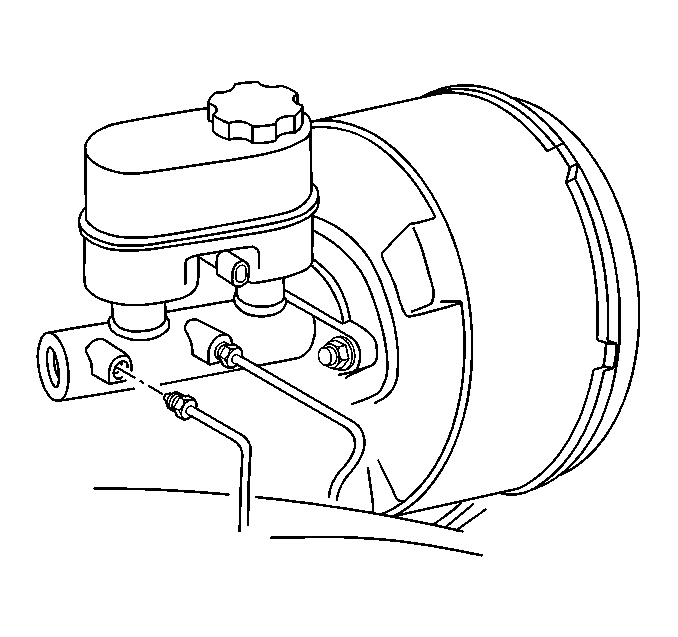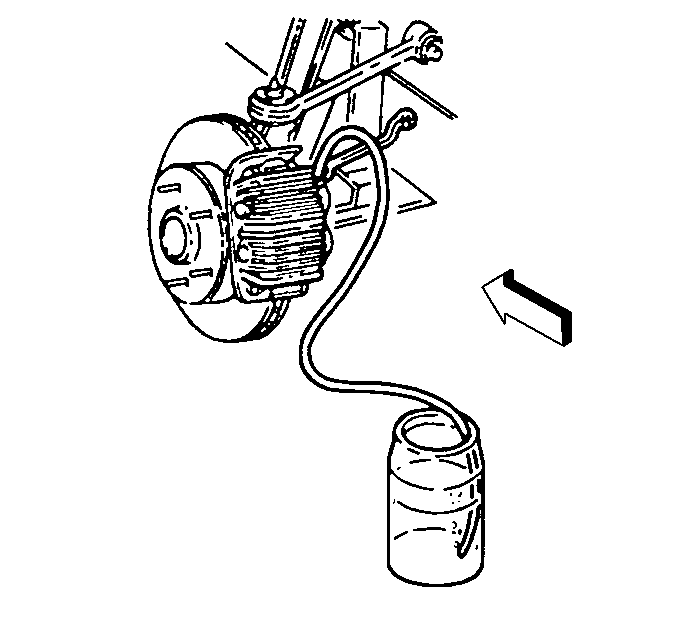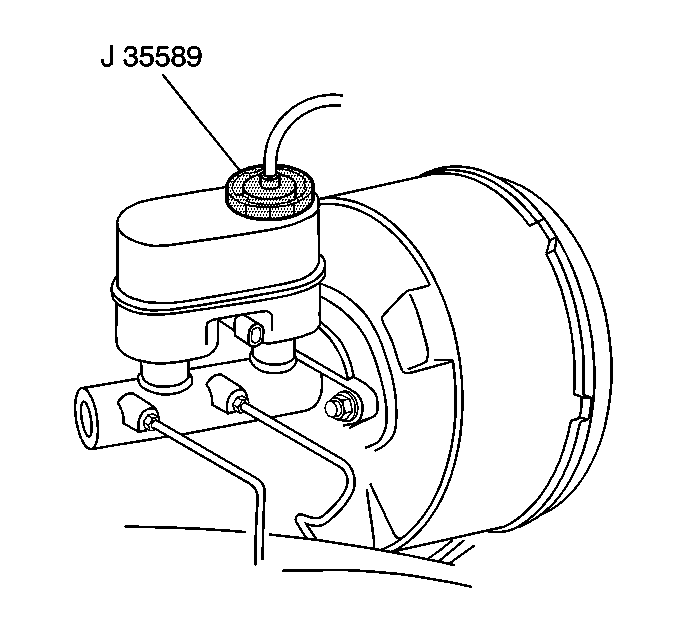Hydraulic Brake System Bleeding Manual Bleeding
The time required to bleed the hydraulic system can be
reduced if the master cylinder reservoir is filled with brake fluid and as
much air as possible is expelled before the master cylinder is installed
on the vehicle. Pumping the piston can evacuate the air from the piston
cavities.
Power brakes require the vacuum reserve be depleted by applying the
brakes several times with the engine off. Care must be taken to prevent brake
fluid from contacting any painted surface.

- Fill the master cylinder
reservoir with brake fluid and keep the reservoir at least half full of fluid
during the bleeding operation.
- If the master cylinder is known or suspected to have air in the
bore, then it must be bled in the following manner, before bleeding any caliper:
| 2.1. | Disconnect the forward (blind end) brake pipe connection at the
master cylinder. |
| 2.2. | Allow the brake fluid to fill the master cylinder piston bore
until it begins to flow from the forward pipe connector port. |
| 2.3. | Connect the forward brake pipe to the master cylinder and tighten. |
Notice: Use the correct fastener in the correct location. Replacement fasteners
must be the correct part number for that application. Fasteners requiring
replacement or fasteners requiring the use of thread locking compound or sealant
are identified in the service procedure. Do not use paints, lubricants, or
corrosion inhibitors on fasteners or fastener joint surfaces unless specified.
These coatings affect fastener torque and joint clamping force and may damage
the fastener. Use the correct tightening sequence and specifications when
installing fasteners in order to avoid damage to parts and systems.
| 2.4. | Depress the brake
pedal slowly one time and hold. Loosen the forward brake pipe connection
at the master cylinder to purge air from the bore. Tighten the connection
and then release the brake pedal slowly. Wait 15 seconds. Repeat the
sequence, including the 15 second wait, until all air is removed from
the bore. |
Tighten
Tighten the brake pipe tube nut to 16 N·m (12 lb ft).
| 2.5. | When clear fluid flows from the forward connection, repeat steps
1 and 2 to bleed the master cylinder at the rear (cowl) connection. |

- Individual brake calipers
are bled only after all air is removed from the master cylinder. If it is
known that the brake calipers do not contain any air, then it will not
be necessary to bleed them.
| 3.1. | Place a proper size box end wrench, or equivalent, over the brake
caliper bleed screw. |
| 3.2. | Attach a clear tube over the screw. |
| 3.3. | Submerge the other end of the tube in a clear container partially
filled with brake fluid. |
| 3.4. | Depress the brake pedal slowly one time and hold. |
| 3.5. | Loosen the brake caliper bleed screw to purge the air from the
cylinder. |
| 3.6. | Tighten the brake caliper bleed screw and slowly release the pedal.
Wait 15 seconds. |
Tighten
Tighten the brake caliper bleed screw to 12 N·m (106 lb
in).
| 3.7. | Repeat the sequence (including the 15 second wait), until all
of the air is removed. It may be necessary to repeat the sequence ten or more
times to remove all of the air. |
| 3.8. | If it is necessary to bleed all of the brake calipers, the following
sequence should be used: |
| 3.9. | Test drive the vehicle. Check the brake pedal for sponginess. |
| 3.10. | Ensure that vehicle exceeds 5 km/h (3 mph) for ABS modulator
actuation (self-test). If after ABS modulation the brake pedal is spongy
or soft, then re-bleed system until pedal is firm. |
Hydraulic Brake System Bleeding Pressure Bleeding
Tools Required
J 35589 Pressure Bleeding
Adapter

- Remove the master cylinder
reservoir cap. Replace it with J 35589
.
- Charge the bleeder to 140-172 kPa (20-25 psi).
- Connect the hose to J 35589
.
- Raise and suitably support the vehicle. Refer to
Lifting and Jacking the Vehicle
in General Information.

- If it is necessary to
bleed all of the brake calipers, the following sequence should be used:
- Place the proper size box end wrench, or equivalent, over the
brake caliper bleed screw. Attach a clear tube over the screw and allow the
tube to hang submerged in a clear container partially filled with brake
fluid.
- Open the brake caliper bleed screw at least three quarters of
a turn and allow the brake fluid flow to continue until no air is seen in
the brake fluid. Apply intermittent pressure to the brake pedal while pressure
bleeding.
Notice: Use the correct fastener in the correct location. Replacement fasteners
must be the correct part number for that application. Fasteners requiring
replacement or fasteners requiring the use of thread locking compound or sealant
are identified in the service procedure. Do not use paints, lubricants, or
corrosion inhibitors on fasteners or fastener joint surfaces unless specified.
These coatings affect fastener torque and joint clamping force and may damage
the fastener. Use the correct tightening sequence and specifications when
installing fasteners in order to avoid damage to parts and systems.
- Close the brake caliper
bleed screw.
Tighten
Tighten the brake caliper bleed screw to 12 N·m (106 lb in).
- Repeat steps 6 through 8 until all of the calipers have been bled.
- Lower the vehicle.
- Test drive the vehicle, checking for brake pedal for sponginess
or softness. Ensure that vehicle exceeds 5 km/h (3 mph) for ABS modulator
actuation (self-test) which will purge any air from the secondary circuit
of the modulator. If after ABS modulator actuation the pedal is still soft
or spongy, then re-bleed entire system.
- Remove the brake bleeding equipment from the master cylinder.
Hydraulic Brake System Bleeding When To Bleed
A bleeding operation is necessary to remove air when it
is introduced into the hydraulic brake system.
It may be necessary to bleed the hydraulic system at all
four corners if air has been introduced through low fluid level or by disconnecting
brake pipes at the master cylinder. If a brake hose is disconnected at
one wheel, only that wheel caliper needs to be bled. If brake pipes or
hoses are disconnected at any fitting located between master cylinder and
brakes, then the brake system served by the disconnected pipe or hose must
be bled.




